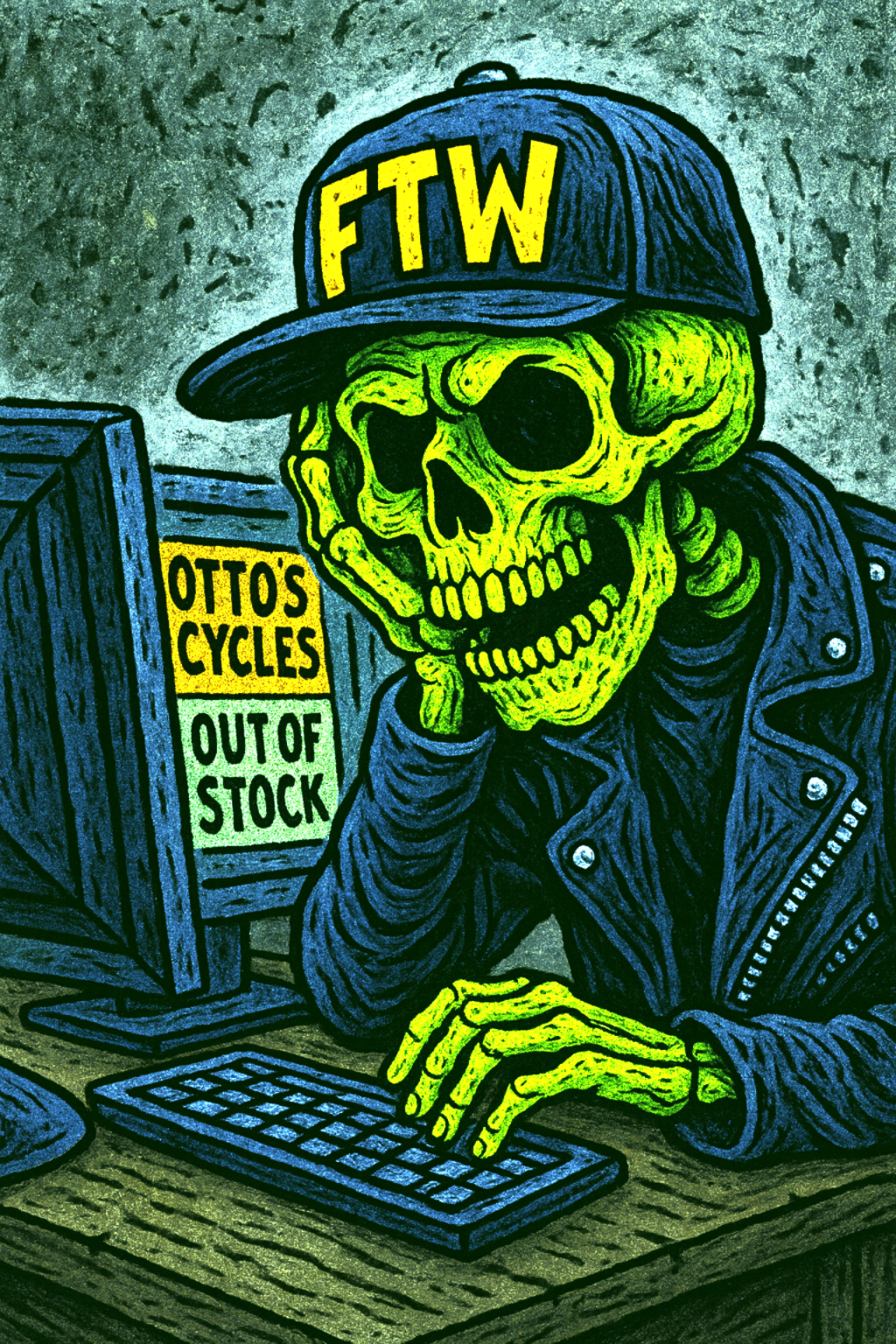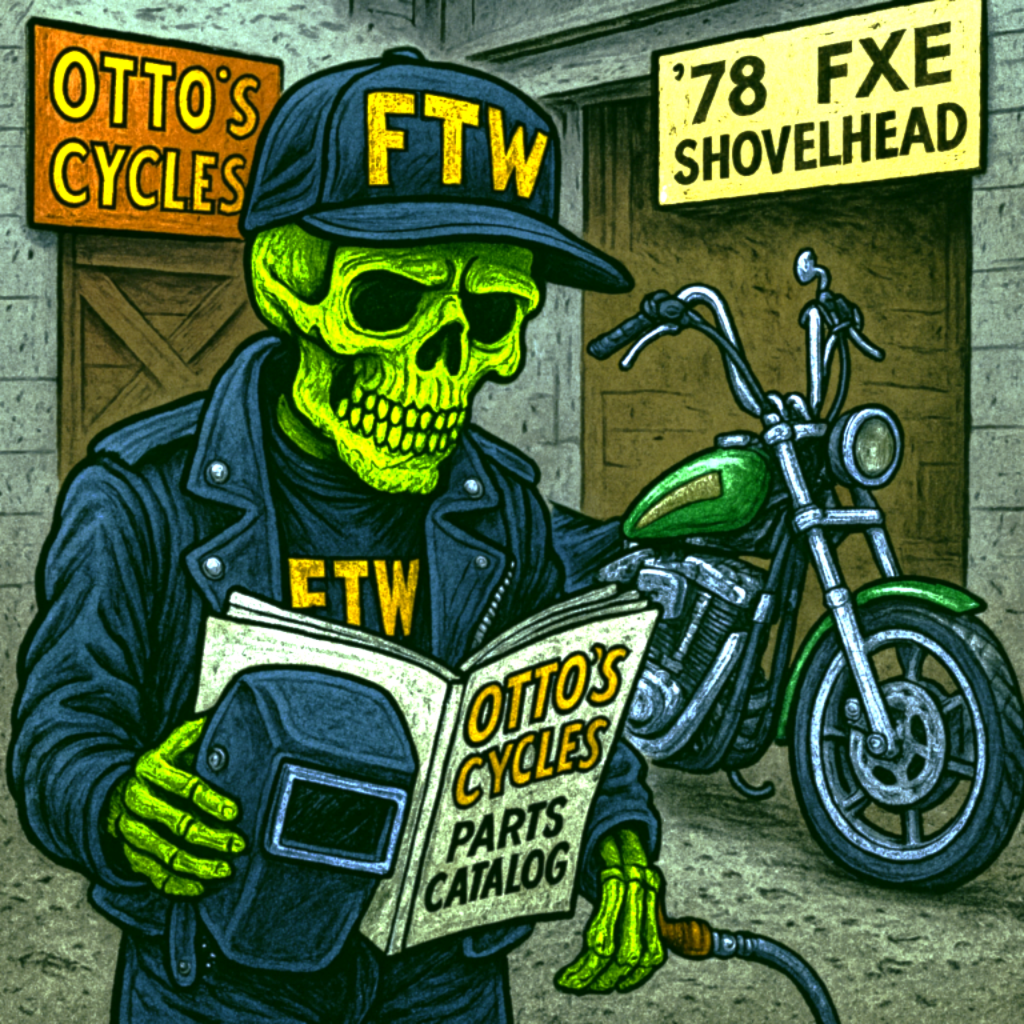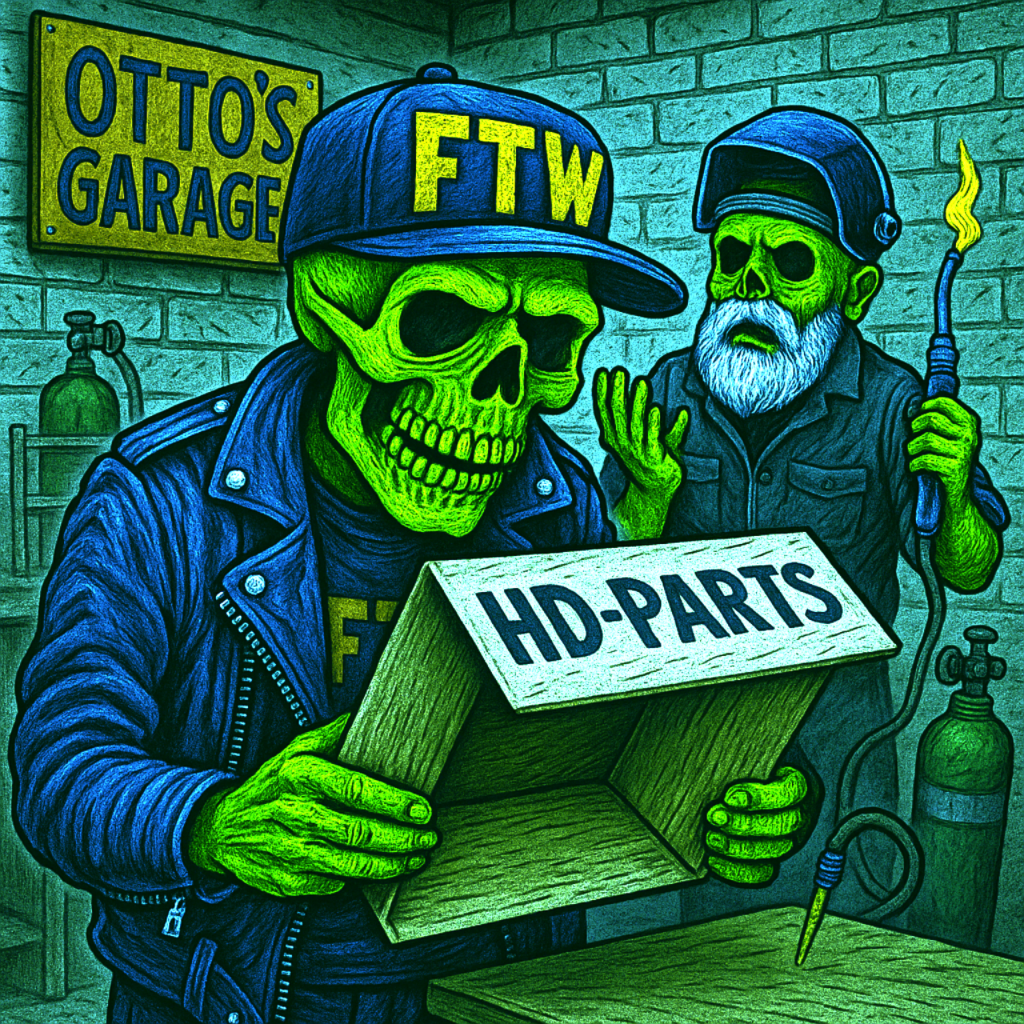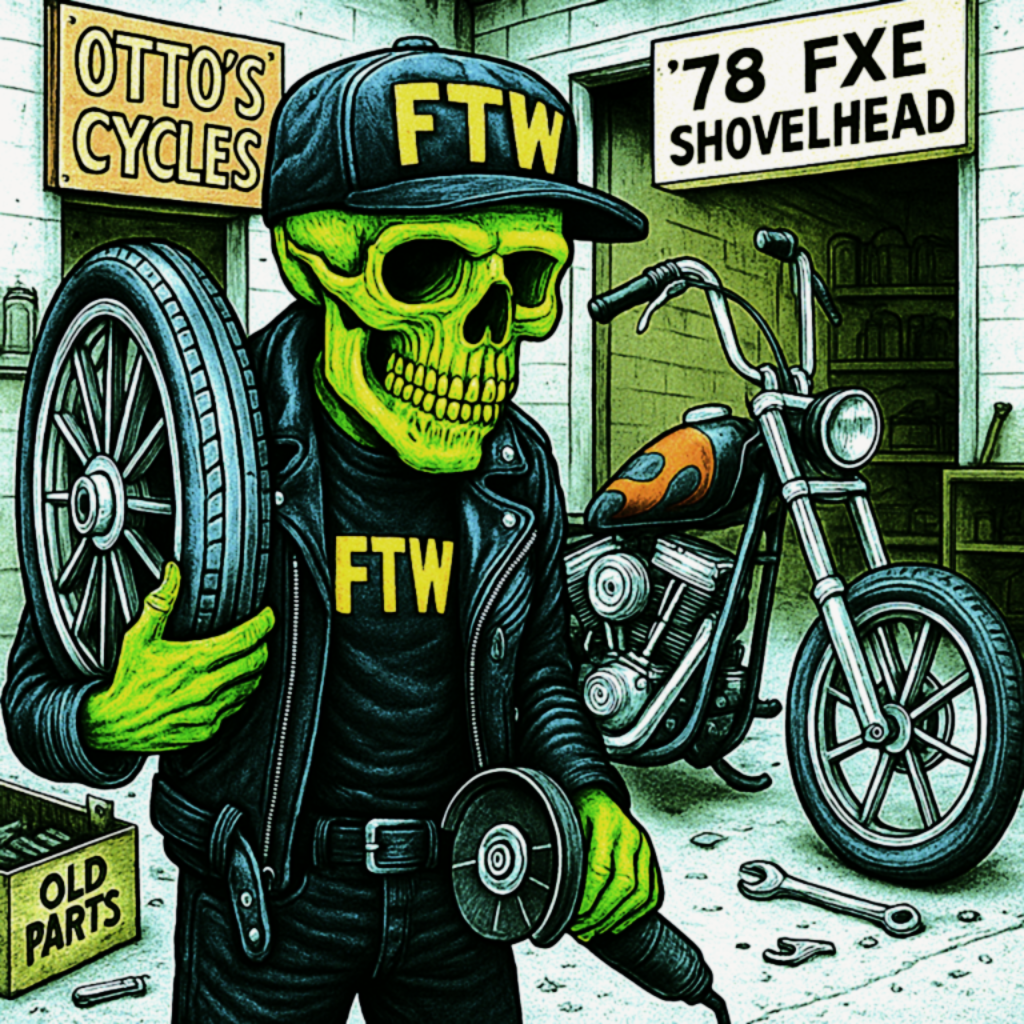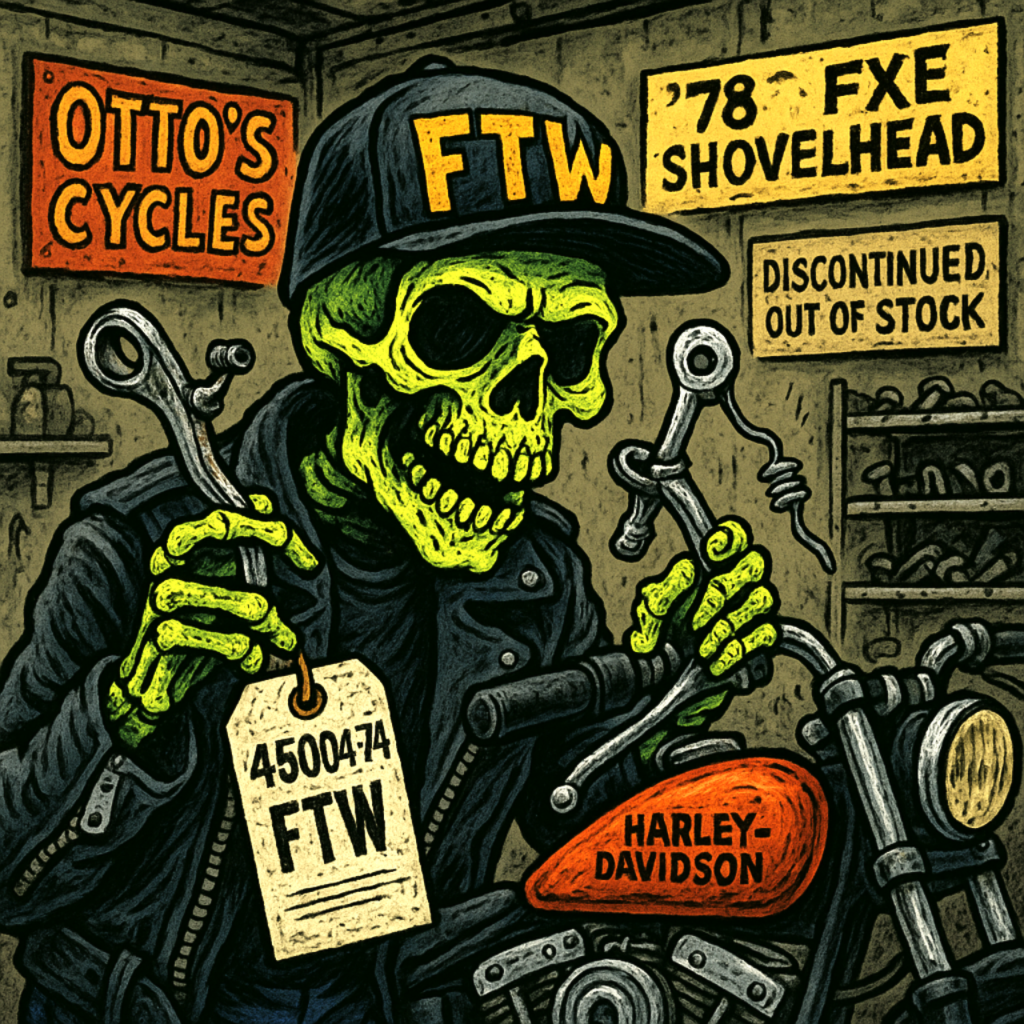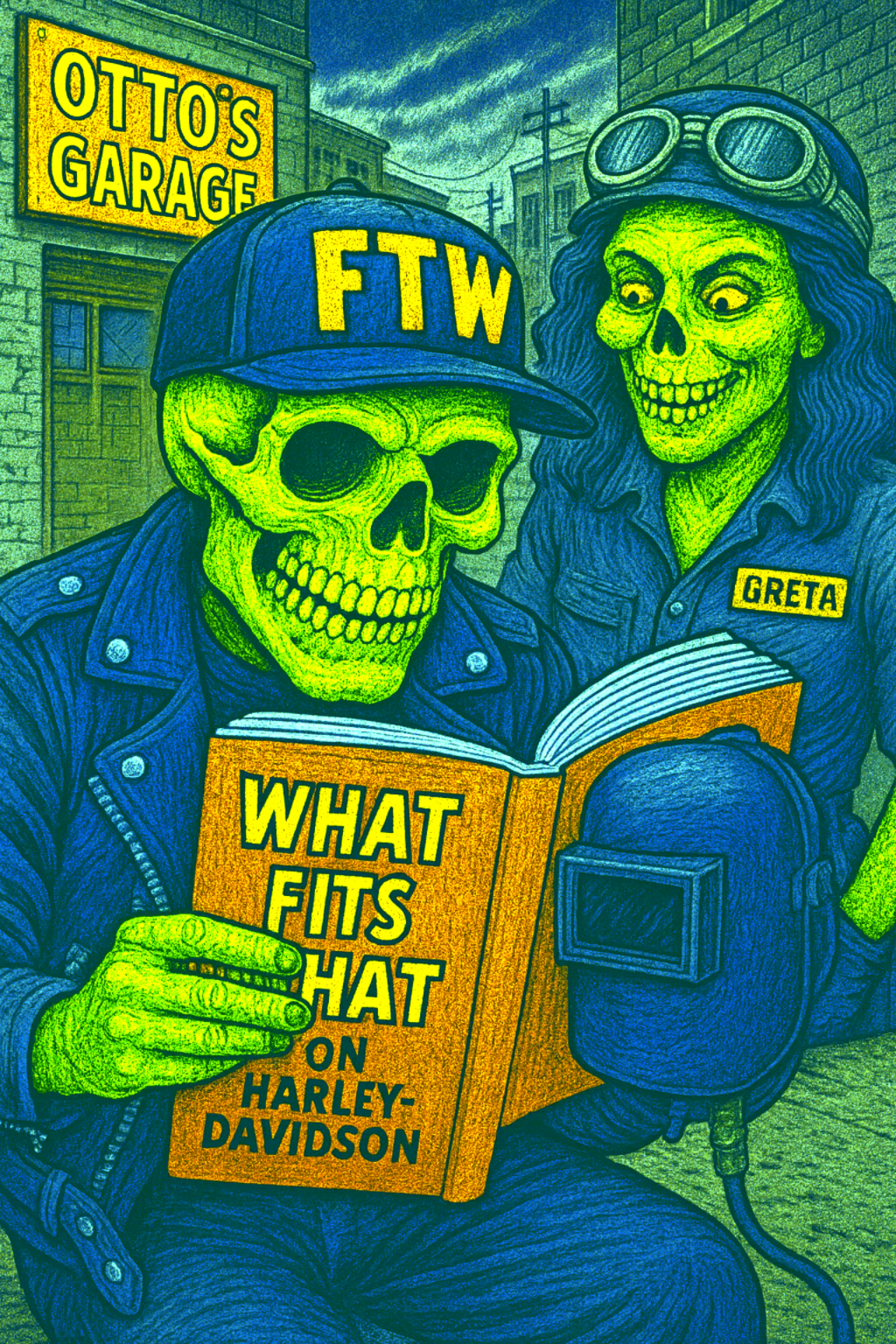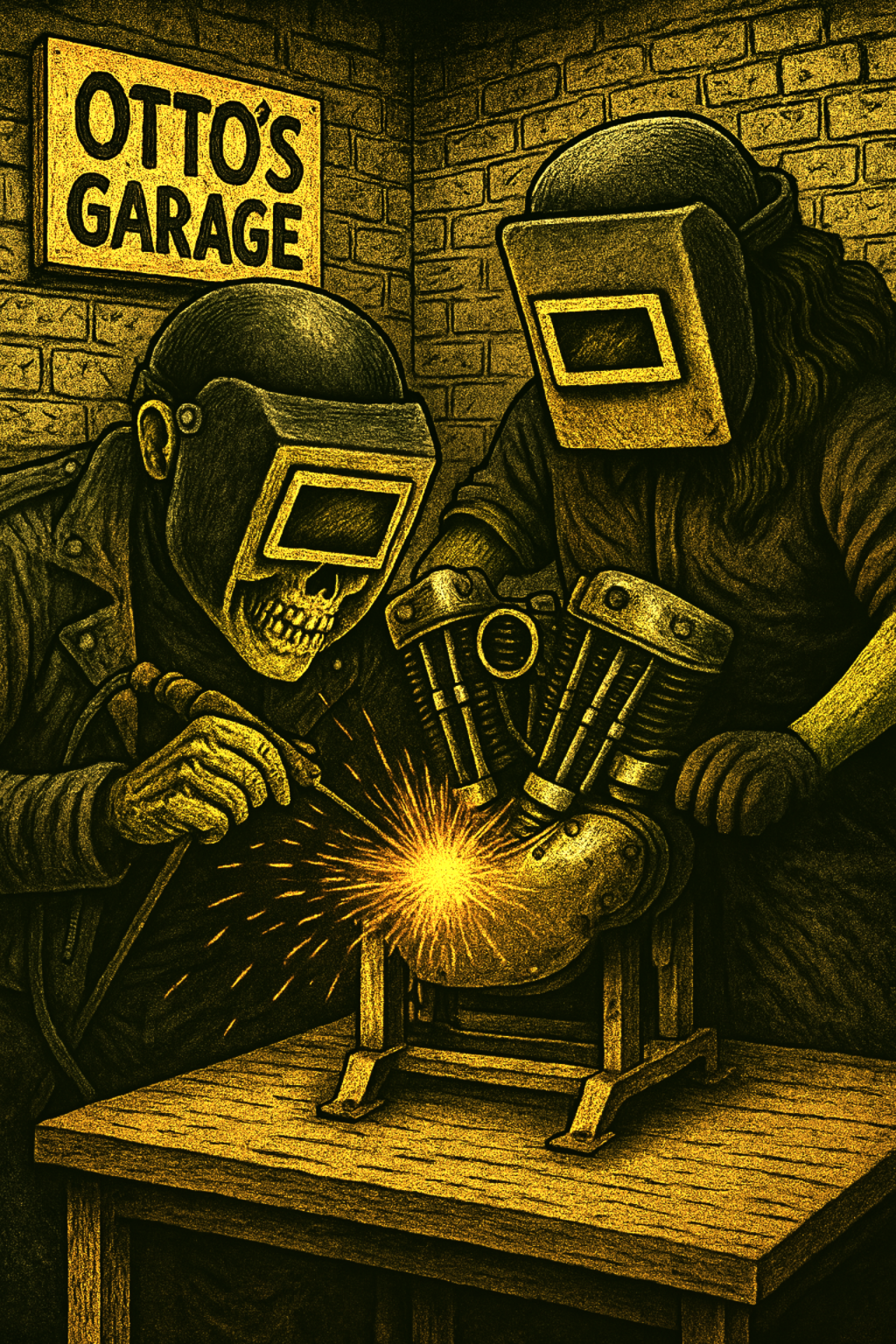Out of Stock, Not Out of Luck: Keeping Old Harleys Alive
Ghost Parts and Dead Ends
Every Harley is a liar. The parts book says it’s one thing, the bike says it’s another, and you’re stuck in the middle with a wrench in one hand and bad language in the other. You’ve got a ’78 FXE Shovelhead, and your clutch lever flops like a wet noodle. The pivot pin’s ovalled out the perch, the lever’s scarred from years of glove snaps, and the return spring is one ride away from snapping in half. You punch in the part number and hit the same wall every old Harley wrench eventually knows: discontinued, out of stock, or priced like rare art. The swap meet bins are full of rusted junk, the reproductions are just “close enough,” and no dealership’s had the real thing in decades.
And it’s never just the clutch. Maybe it’s a Bendix carb body cracked beyond repair, a speedo that’s been dead since Reagan was president, or the one set of head pipes that actually clears your kicker and bags. Each time, it’s the same ritual — hunt the number, find it’s gone, weigh the gamble on repros, and dig through swap meet piles like an archaeologist. You might be chasing those FXE factory head pipes because nothing else routes quite right with your bags and kicker setup. Harley stopped making them decades ago, and the so called “good used” ones are usually dented, warped, or welded in all the wrong places. The guys online call them unicorn pipes, and if you’re hunting the matching heat shields too, you might as well take a week off work. Even the better reproductions tend to throw off your muffler fitment just enough to make you curse.
Maybe it’s the speedometer that’s been dead longer than most riders’ marriages. You finally go looking and find NOS units priced like they’re made of platinum, or used ones missing the trip reset. The forums are full of horror stories about reproduction speedos with bounce, bad calibration, and face fonts so wrong you can spot ’em from across the street. Or you’re chasing original tanks and fenders, the ones with the right rivets, hinge tabs, and stamp details — not the repops that look good from ten feet away but give themselves away up close. AMCA and Hydra-Glide forum regulars swap tips on spotting fakes, because true OEM tin is usually buried in a barn or bolted to a bike that’s not leaving its owner’s garage in this lifetime.
Then there are the matched engine cases, the ones with the correct belly numbers and an honest VIN pad. That’s the holy grail for a numbers correct restoration, but what you usually find are mismatched halves, questionable restamps, or cases that’ll cost you more in repairs than the rest of your build. And that’s just the Shovel crowd — Evo owners have their own nightmares. FXR side covers, especially the metal ones, are called “mission impossible” for a reason. Chopper Guys and other small makers stopped producing them years ago, and when a clean set shows up, they’re gone before you can type a message. The FXRT fairings and brackets aren’t much better — everyone wants the look, but most of what’s out there is cracked, half repaired, or priced high enough to make you rethink the whole project.
Cycle Shack’s old 2-into-1 systems? They’re like opening a time capsule, and even the dented ones vanish fast. The right FXR transmission side or door cover — whether you’re running mids or floorboards — can stall a build entirely, because owners hoard them and good originals almost never hit the open market. And if you’re chasing a correct mechanical speedo drive for certain gearboxes, be ready to compromise. A lot of guys just give up and run GPS or front-wheel drives, because when originals do pop up, they usually need a rebuild anyway.
That’s the reality of vintage Harley ownership. It’s not just about keeping the motor running — it’s about tracking down the parts nobody else can find, decoding eBay listings with two blurry photos, and knowing exactly which guy in which forum might have one under his bench. Because when Harley stopped making these parts, they didn’t just go out of stock — they became a rite of passage for anyone stubborn enough to keep these machines on the road.
You build the setup that works. Welcome to the world of fitment alchemy.
Why Harley Parts Disappear
Try chasing down a left side switch housing for a ‘76 FXE, or an original oil tank for the same bike, and you’ll quickly learn this truth: Harley parts disappear. Not because they were bad. Not because nobody cared. But because time, business, and bureaucracy don’t care about your restoration dreams.
Harley Davidson doesn’t keep every old part in production forever. They’re not running a heritage museum they’re running a business. Once a part stops moving in volume, it gets pulled. Warehouse space is finite. The focus shifts to the latest model year, the newest platform. If that crusty old component doesn’t serve a Twin Cam or an M8, chances are it’s getting dropped. You won’t find it at the dealer. You won’t see it in the official catalog. It’s gone unless you know where to dig.
Then there’s the issue of those weird in between years. Harley’s history is full of one offs and short runs those oddball parts that only existed for a year or two. You’ve got brake setups, control pods, dash panels, and wiring harnesses that only fit a ‘78 or a ‘74, and when those parts vanish from the aftermarket, you’re left in the dark.
Sometimes, it’s the basics that disappear first ignition switches, handlebar controls, turn signal buttons. They were cheap, they wore out, and nobody thought to stash extras when they were easy to find. Now they’re unobtanium. Add EPA and DOT rules wiping out carbs, open pipes, and old lighting setups, and the list gets shorter every year.
Old bikes demand compromise. That might mean ditching the clutter, simplifying wiring, or swapping the factory controls for a hidden toggle. Does it match the parts book? No. Does it work? Absolutely.
Real World Harley Fixes
You’re elbow deep in your ‘78 FXE project and the clutch refuses to disengage cleanly. You crack open the primary and there it is the release finger worn to a nub. Every listing says: Out of Stock. Harley hasn’t had it in decades, and the rare survivors are either hammered or priced like they’re cast in gold. Aftermarket replacements exist, but too many are soft metal junk that fail before you’ve finished bragging about the repair.
Same deal with an early Evo oil tank bracket. Those mid ‘80s Softail setups had some odd oil tank and battery tray arrangements, and one guy rebuilding an ‘86 FLSTC found his tank sitting crooked, rattling like hell. The lower bracket had been hacked off in some past “custom” job, and replacements were long gone. So he made one a cardboard template to steel, grinder, drill, TIG weld. Now the tank sits square, doesn’t leak, and doesn’t vibrate.
Or the chopper speedo problem. Hardtail a Sporty or chop an FXR, and your wheel spacing changes, wiping out the mechanical speedo drive. One builder with a narrowed swingarm Sporty could’ve chased some unicorn bracket, but instead he went modern: Quad Lock phone mount, GPS speed app. No cables, no gears, no guesswork. Another rider went with a 2.4 inch mini electronic speedometer that works with any sending unit, pumping 3,000 to 90,000 pulses per mile.
Sometimes the workaround isn’t just about making something fit — it’s about finding a whole new way to solve the problem. One rider with a ’79 FXE had the factory ignition switch ripped out and welded over. He wanted it clean—no bulky dash, no tank console—but still needed a reliable on/off switch. The stock-style switch was either overpriced, junk quality, or wouldn’t mount. So he went off script: marine grade keyed ignition switch from a boat supply store waterproof, three position, solid brass internals — twenty bucks. Bent an L bracket from 16-gauge steel, tucked it under the seat tab, ran two 12-gauge wires into the loom with soldered, heat shrink terminals, and shot it black until it vanished. Not stock. Not in any Harley parts book. But solid, weatherproof, and works every time.
And then there’s making a Mikuni HSR play nice with old Shovel hardware. The HSR42 is a gift for performance, but it won’t bolt up to Bendix manifolds different bolt spacing, bad bracket geometry. One rider grabbed flat bar steel, notched it to clear the pushrod tubes, shaped a backing plate in a vise, and made it fit. Now the carb breathes crisp, clears the frame, and doesn’t budge.
That’s the thread custom brackets, borrowed parts from other industries, and hand shaped fixes. Because when Harley stops making it, you either find it, build it, or ride without it.
Modifying What’s Close
So you can’t find the original part. Welcome to the club. This is when every old Harley rider turns into a fabricator because instead of hunting for the perfect match, you start scanning swap meets, boat shops, tractor supply aisles, and your own scrap pile for something that’s close enough to bully into place.
Trying to find a specific riser set? The offset is weird, the threads are some long dead pitch, and the bushings have been extinct since Reagan was in office. You spot a set off a mid 2000s Dyna. Not a perfect fit — yet. A couple washers, a grinder pass to shave the base, a tap to chase the threads, and suddenly your front end feels like a steel I-beam instead of wet spaghetti.
Or the rear wheel problem. Your mechanical speedo drive won’t fit your new swingarm spacing, and the original part hasn’t been made since disco died. You could waste months chasing a unicorn… or you bolt in a newer hub and ditch the cable altogether for a GPS speedo. It doesn’t care about gear ratios. Doesn’t care about axle width. Hell, it doesn’t even care what decade your bike is from. It just works.
And then there’s the stuff no one writes about — the fenders you slot new holes into because the curve almost matches your tire, the brake caliper bracket you cut and reweld so it clears a spoke hub, the random lawn tractor bushing that becomes your new shift lever spacer.
Controls, brackets, seats, tanks nothing is sacred. If stock holes don’t line up, you drill new ones. If a bolt is too short, you make a spacer. If a bracket interferes, you bend it, cut it, weld it, or build it from flat bar and stubbornness.
Because in this game, “close enough” isn’t a compromise. It’s the first step toward something better than stock — something built your way.
The Art of the Swap
Harleys have always been a patchwork. Even in the showroom, they were parts bin specials castings reused, part numbers shuffled, and components carried over from bikes built years earlier. The whole platform was designed on interchange. That’s not a hack. That’s the DNA.
Before forums and Facebook groups, the real swap gospel was a dog eared copy of What Fits What on Harley-Davidsons by Mike Arman and Kurt Heinrichs. It wasn’t bedtime reading — it was a survival manual. Paired with Easyriders published series called Tech Tips & Tricks. These books provide page after page of information on exactly which motors, transmissions, wheels, gears and brake setups could be swapped across decades of Harley production, from Knuckle to Evo. If you didn’t have one, you borrowed your buddy’s. If he didn’t have one, you made friends with someone who did.
Engine swaps were the big ticket magic. Late Panhead bottom ends will take early Shovel top ends with little more than a gasket change and oiling tweaks mid-’60s Shovels are basically Pan motors with new heads. Pushrods? Slight length change, but adjustables make it easy. Cams and lifter blocks? Same journal sizes and gear pitch in that crossover window. Even the late Pan external oil pumps will bolt right to an early Shovel case.
Fast forward a decade and you’ve got the Shovel to Evo bridge years. Early’80s Shovel bottom ends share the spline crank and rotor setup with early Evos, which means some brave builders have mated complete Evo top ends to late Shovel cases. Oil pumps from the last Shovels bolt straight onto early Evos, often giving better volume than stock. The camshafts don’t interchange outright — but the profiles do, if you’ve got a grinder who knows what they’re doing.
And it’s not just motors. A rear caliper off a 2000 Dyna will damn near bolt onto a ’91 FXR with a simple bracket tweak and a banjo adapter. Same piston size, same spacing, same stopping power — and you’re riding instead of scrolling eBay for weeks. Early Sportster pegs stripped out? Late model Evo pegs slide right in if you know the trick. Want to smooth out the ride on a 1992 Super Glide FXR? A pair of Drag Specialties Ride Height Adjustable Shocks from a 2002 XL1200 will do the job without complaint.
Sometimes a swap is about making it run. Other times, it’s about making it look right. Drop 39mm Dyna frontend guts into a narrowed triple tree and your chopper handles better while looking like it just rolled out of a ’70s centerfold. Can’t find the right mid control shifter arm? A Buell piece will clear the primary and tuck in tighter than stock. That mismatched clutch perch from a newer Softail? Works just fine on a set of custom bars.
Swapping parts isn’t cutting corners it’s tradition. Guys in the ’60s and ’70s weren’t chasing period correct builds for museums. They were using whatever worked, whatever looked good, and whatever got them to the next ride. That’s still the move today. The only difference is, now you’ve got fifty more years of Harley parts to play with.
The art of the swap is knowing the bolt patterns, the bearing sizes, the geometry and having the guts to try it. Because when the exact part you need doesn’t exist anymore, something close will. And close is just the start of getting back on the road.
Cracked Case, Hot Glue.
When It’s Time to Fabricate
At some point, the part you need just doesn’t exist anymore. That’s when fabrication stops being a last resort and becomes the rite of passage.
A brake stay for your axle combo, a coil bracket that clears your petcock, a battery tray that actually fits your oil tankthese aren’t show bike touches, they’re survival mods.
Your Shovel’s seat tab cracked off? A chunk of angle iron, a cutoff wheel, a few weld beads, and it’s stronger than before. Clutch cable too short or too long? Cut and solder a ferrule, fab an anchor plate, and route it clean.
Fabrication turns “almost fits” into “fits perfectly.” Sometimes it’s just a grinder, a vise, and patience. Other times, it’s knowing the machinist down the street who’ll spin you a spacer or TIG something you can’t stick clean.
And when you’re out of ideas, you hit the forums. Chop Cult, XLForum, and Hydra-Glide.net are gold mines of past solutions.
Knowing When to Say Good Enough
Every build hits that point where you’ve got to decide: are you chasing a finished bike, or chasing an illusion?
Perfection is a trap. Matching numbers, perfect symmetry, NOS only builds they’ve got their place. But if you actually want to ride, you’ve got to know when to let go.
That mismatched riser spacer? If it holds torque and clears the tank, it’s good enough. That marine ignition switch? If it starts the bike every time, it’s good enough. That bracket you hacked from scrap? If it doesn’t crack or rattle loose, it’s good enough.
Safety matters. Rideability matters. But chasing perfect casting stamps when it doesn’t affect the ride will bury a bike in the garage for years. Every scratch, every workaround, every fabbed bracket is a badge. It says the bike was built, not bought — and that’s worth more than any indoor show trophy.
Trust your work. Ride your fix. And when it holds together on the road, you’ll know: you didn’t settle — you finished.
